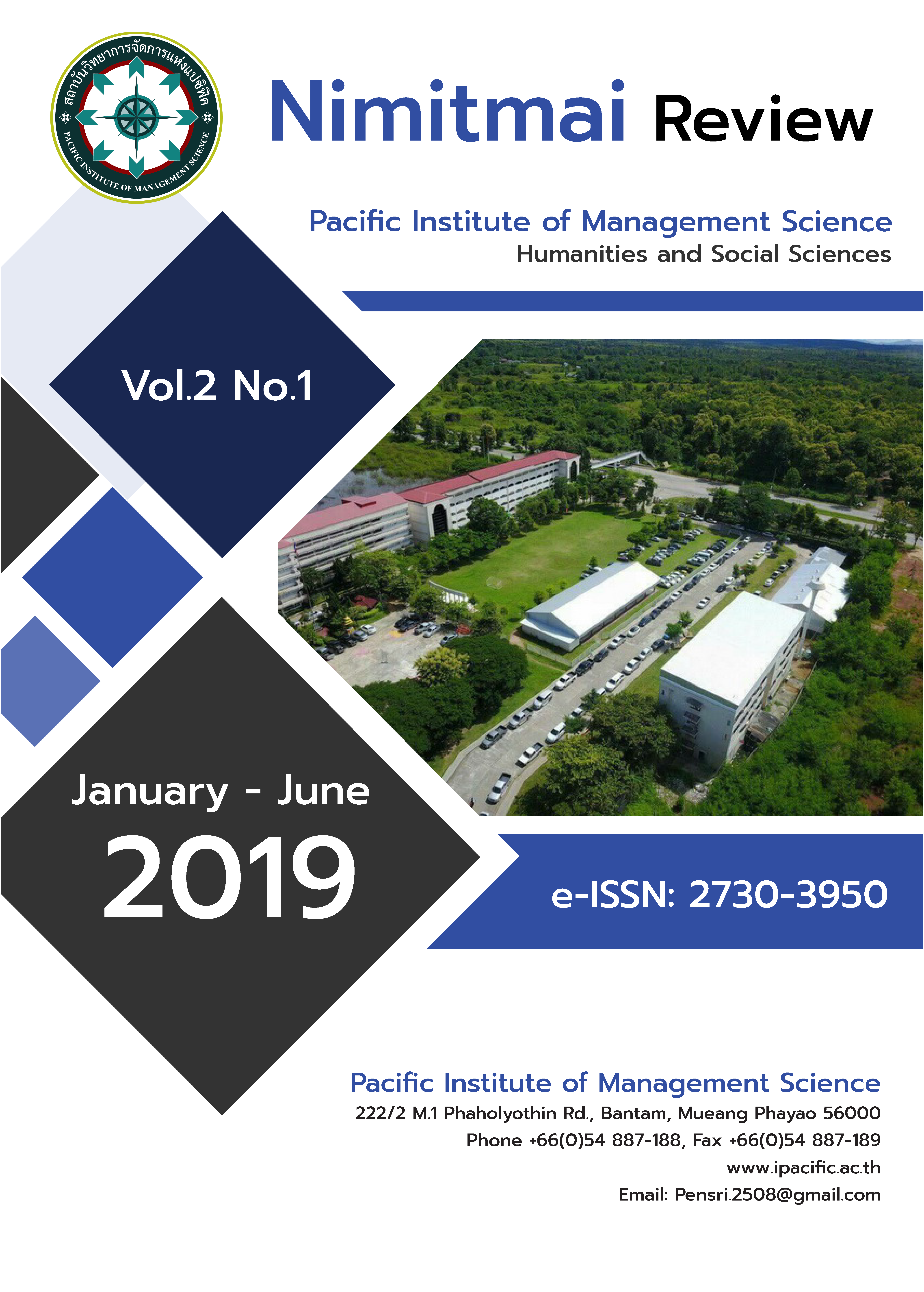STUDYING GROUP TOURS TO XISHUANGBANA, CHINA FOR STRATEGIC IMPLICATIONS
Keywords:
Xhishuangbanna, Tourist behavior, Stimulus Organism Response (SOR), Tour guide, Destination images, Tour programAbstract
This research is motivated by a lack of knowledge explaining how tour operator can make use of how the tourists perceive and react to the destinations targeted, and the overall tour services and the tour guide arranged, to formulate tour operations strategies to yield similar-trip performances and tourist loyalty to similar trips. Seven hypotheses were assumed and organized in a stimulus-organism-response (SOR) theory and model of tourist behaviors, which included the moderating role of “perceived trip personality matching”. The data were collected with the help of a tour operator bringing Thai tourists to Xhishuangbanna, China, via the R3A route, from Chiang Rai, stopping over to Laos and various other places located in the proximity of Xhishuangbanna. A total of 118 valid data were collected. Structural equation modeling (SEM) analysis demonstrated excellent model fits, and yielded a significant level of ability in variance explanation of the dependent variables, as evidenced in R^2 in the ranges between 0.34-0.53. Numerous important implications are derived, which include trip personality matching and concept of marketing centralizing on “experiencecapes”
References
Balogly, S. and McCleary, K. (1999). A Model of Destination Image Formation. Annals of Tourism Research, 26(4), pp. 868-878.
Baloglu, S. and Mangaloglu, M. (2001). Tourism Destination Images of Turkey, Egypt, Greece, and Italy as Perceived by US-based Tour Operators and Travel Agents. Tourism Management, 22(1), pp. 1-9.
Beerli, A. and Martin, J.D. (2004). Tourists’ Characteristics and the Perceived Image of Tourist Destinations: A Quantitative Analysis: A Case Study of Lanzarote, Spain. Tourism Management, 2595), pp. 623-636.
Cai, L.A. (2002). Cooperative Branding for Rural Destinations. Annals of Tourism Research, 29(3), pp. 720-742.
Cohen, E. (1979). A Phenomenology of Tourist Experience. Sociology, May.
Daniel, Y.P. (1996). Tourism Dance Performances Authenticity and Creativity. Annals of Tourism Research, 2394), pp. 780-797.
Echtner, C.M. and Ritchie, J.B. (2003). The Meaning and Measurement of Destination Image. Journal of Tourism Studies, 14(1), pp. 38-48.
Ellis, A., Park, E., Kim, S., and Yeoman, I. (2018). What is Food Tourism? Tourism Management, 68, pp. 250-263.
Fornell, C. and Larcker, D.F. (1981). Evaluating Structural Equation Models with Unobservable Variables and Measurement Error. Journal of Marketing Research, 18(1), pp. 39-50.
Grant, M., Human, B., and Le Pelley, B. (2002). Destinations and Local Distinctiveness. Tourism Intelligence Papers, July, pp. 21-28.
Hall, C. and Williams, A. (2008). Tourism and Innovation. London: Routledge.
Hernandez-Mogollon, J., Duarte, P.A. and Folgado-Fernandez, F. (2018). The Contribution of Cultural Events to the Formation of the Cognitive and Affective Images of a Tourist Destination. Journal of Destination Marketing & Management, 8, pp. 170-178.
Holbrook, M.B. and Hirschman, E. (1982). The Experiential Aspects of Consumption: Consumer Fantasy, Feelings and Fun. Journal of Consumer Research, 9(2), pp. 132-140.
Jiang, T., Ryan, C. and Zhang, C. (2018). The Spiritual or Secular Tourist? The Experience of Zen Meditation in Chinese Temples. Tourism Management, 65, pp. 187-199.
Kani, Y., Aziz, Y.A., Sambasivan, M. and Bojei, J. (2017). Antecedents and Outcomes of Destination Image of Malaysia. Journal of Hospitality and Tourism Management, 32, pp. 89-98.
Lugosi, P. (2014). Mobilizing Identity and Culture in Experience Co-Creation and Venue Operation. Tourism Management, 40, pp. 165-179.
Martin-Santana, J.D., Beerli-Palacio, A. and Nazzareno, P.A. (2017). Antecedents and Consequences of Destination Image Gap. Annals of Tourism Research, 62, pp. 13-25.
Matson-Barkat, S. and Demontrond, P.R. (2018). Who’s On the Tourists’ Menu? Exploring the Social Significance of Restaurant Experiences for Tourists. Tourism Management, 69, pp. 566-578.
Moon, K., Ko, Y.J., Connaughton, D.P. and Lee, J. (2013). A Mediating Role of Destination Image in the Relationship between Event Quality, Perceived Value, and Behavioral Intention. Journal of Sports & Tourism, 18(1), pp. 49-66.
Moutinho, L. (1987). Consumer Behavior in Tourism. European Journal of Marketing, 21(10), pp. 5-44.
Pine, B.J. and Gilmore, H.J. (1998). Welcome to the Experience Economy. Harvard Business Review, 76, pp. 97-105.
Qu, H., Kim, L.H., and Im, H.H. (2011). A Model of Destination Branding: Integrating the Concepts of the Branding and Destination Image. Tourism Management, 32, pp. 465-476.
Sanchez, J., Callarisa, L., Rodriguez, R.M. and Moliner, M.A. (2006). Perceived Value of the Purchase of a Tourism Product. Tourism Management, 27, pp. 394-409.
Sorensen, F. and Jensen, J.F. (2015). Value Creation and Knowledge Development in Tourism Experience Encounters. Tourism Management, 46, pp. 336-346.
Sundbo, J. and Hagedorn-Rasmussen, P. (2008). The Backstage of Experience Production. In J. Sundbo and P. Darmer (Eds.) Creating Experiences in the Experience Economy (pp. 83-110). Cheltenham, UL. And Northampton, MA, USA: Edward Elgar.
Tan, C.C. (2017). A Field Trip Approach to Studying the Role of Tour Guides in Shaping the Tourist Experience. Journal of Mekong Societies, 13(2), pp. 23-44.
Tan, C.C., Phakdeephirot, N. and Sereewichayaswat, W. (2019). Fieldtrip Advantages for Tourism Students: Contributing towards Hierarchical Aspect of the Stimulus-Organism-Response (S-O-R) Theory. Accepted for publication to Dusit Thani College Journal, September-December 2019.
Tegegne, W.A., Moyle, B.D. and Becken, S. (2018). A Qualitative System Dynamics Approach to Understanding Destination Image. Journal of Destination Image & Management, 8, pp. 14-22.
Williams, P. and Soutar, G.N. (2009). Value, Satisfaction and Behavioral Intentions in An Adventure Tourism Context. Annals of Tourism Research, 36(3), pp. 413-438.



